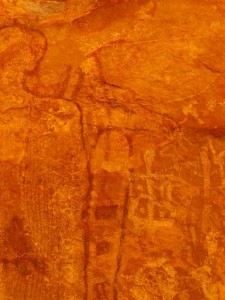The historical significance of the Grand Canyon is nearly impossible to sum up in a few paragraphs – pages, even. From its remarkable creation, to its contribution to modern civilization, to its breathtaking views and haven for some of earth’s most treasured creatures, the f the Grand Canyon plays a significant role in our nation’s history.
Creation
How was the Grand Canyon, one of the most impressive natural phenomena in the world formed? While it’s nearly impossible to know for sure, scientists have made many hypotheses over the years to support its grandiose formation.
In geological terms, the Grand Canyon was created at warp speed spanning approximately six million years. Together with the powerful shifting of the earth’s continental plates, the Colorado River, still a force to be reckoned with, was even mightier in its early days. Water ran so fiercely over land and rock it gouged the land exposing rock layers created more than a billion years ago.
Native Tribes

Long before man settled there, the Grand Canyon became home to the Paleo-Indians and the Ancestral Puebloan people. They were hunter/gatherer societies who lived in caves and pueblos. It is thought some sort of catastrophic event took place around 1200 CE – perhaps a drought or climate change – because shortly thereafter, the tribes moved away. For many years the Canyon remained free of human life. Then around 1300 CE, the Cerbat, forefathers of the Hualapai and Havasupai tribes, moved into the area along with the Navajos or Diné, as they are called in their own language. In the early 1880’s, the Native American tribes were moved onto reservations, a United States government project that sparked the Indian Wars.
Today, the Navajo Nation’s largest reservation lies directly next to the eastern border of the Grand Canyon. To the west lie the Havasupai and Hualapai reservations. You can visit them today and be treated to many stories and customs about the land and the people.
Exploration
Westerners didn’t make it to the Grand Canyon until 1540 when Spanish soldiers, led by Garcia Lopez de Cardenas, were brought there by Hopi Indians. Cardenas was sent to find the Seven Cities of Cibola, reputedly filled with riches beyond belief of gold, silver and turquoise. He was unsuccessful in scaling the canyon walls and returned home to report it to be impassable.
Two hundred years later, another attempt to penetrate the Grand Canyon was made by Spanish Priests. Together, with a group of Spanish soldiers, the priests set out hoping to find a route from Santa Fe to California. They traveled along the North Rim near southern Utah. While on their trek, they stumbled upon a crossing known as the “Crossing of the Fathers,” under what is now Lake Powell.
Later that year, another priest set out on an exploratory mission through the area, hoping to convert the natives. He was unsuccessful but gained knowledge of the canyon itself.
After acquiring the land in 1848, an expedition was ordered by the U.S. government in 1857 and led by Joseph Ives. The purpose was to discover if there were any exploitable natural resources in the area, find a route for the railroad and discover the navigability of the Colorado River. Ives determined the area to be valueless and recommended attempts at cultivating the area be abandoned.
A geologist on Ives expedition disagreed and persuaded John Wesley Powell that further exploration was in order. Powell agreed and in 1869 led the first attempt to run the Colorado River, a then muddy and undrinkable, raging course. In their first attempt, a boat was turned over in heavy rapids causing the explorers to lose many supplies. Three men decided the rapids were too dangerous to attempt again and attempted to climb out of the canyon. They were never heard from again. Powell and the rest of his crew, however, successfully completed their journey, making them the first white men to survive running the Colorado River.
Powell returned a few years later and with a crew that included a photographer, an artist who became the ultimate artistic voice of the Grand Canyon, Thomas Moran. These men catalogued the landscape, plant and animal life in the Grand Canyon creating the first real visual history of the region.
Industry and Development
Although the Grand Canyon yielded no gold, pockets of zinc, lead and copper drew miners to the area in the late 1800’s. But mining was decidedly dangerous and difficult in the Grand Canyon and industry soon gave way to tourism. A railway and lodgings were built to accommodate anxious tourists and it became a popular vacation spot for the well-heeled. Eventually roads were developed and more affordable accommodations were put in to attract tourists at all income levels. Today, it is one of the most visited sites in the United States of America.